Green Travel Tips- The Ultimate Guide to Sustainable Travel
6 min read
Green Global Travel –
Green Travel Tips- The Ultimate Guide to Sustainable Travel originally appeared on Green Global Travel.
Green Travel Tips
The Ultimate Guide to Sustainable Travel
If you took a poll asking people whether they’d prefer to be responsible or irresponsible travelers, most would choose the former over the latter. But what does Green Travel even mean? How do you do it? Do you have to sleep in a tent and cook on a solar-powered camp stove to be considered eco-friendly?
The truth is that sustainable travel is all about making simple choices to lessen your negative impact on a given destination. Individually, each one of these choices makes only a small difference. But collectively, becoming more conscious about these little things can have a huge impact.
What we’ve assembled below are 40 Green Travel Tips that EVERY traveler can use to be more eco-friendly. Most of them are ridiculously simple, such as using a refillable water bottle, putting a Do Not Disturb sign on your hotel room door, and buying locally made products rather than imports. But if every one of our 30,000+ unique monthly visitors began incorporating these tips into their travel routine, our collective impact could be amazing!
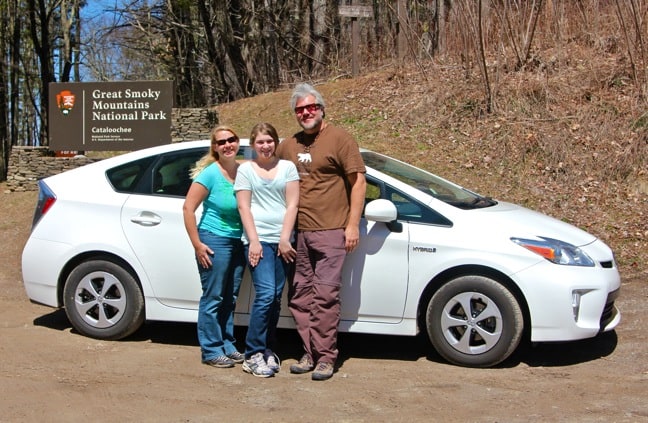
The Toyota Prius We Rented for Our North Carolina Road Trip
TIPS FOR GETTING THERE
1. Book non-stop flights whenever you can: It’s takeoffs and landings that create most of an airplane’s carbon emissions.
2. If you’re traveling with family or friends and the destination is within driving distance, consider taking a road trip. If you’re traveling by yourself, it’s actually more eco-friendly to fly!
3. If you do fly, consider doing so with one of the 30+ IATA (International Air Transport Association) member airlines who offer carbon offset programs to neutralize the aircraft’s carbon emissions by investing in carbon reduction projects.
4. If you drive and your car isn’t eco-friendly, rent a hybrid or electric vehicle, which use less fuel and produce less carbon emissions than gas-guzzlers.
5. If you have the time, traveling via bus, train, or ship generally has less environmental impact.
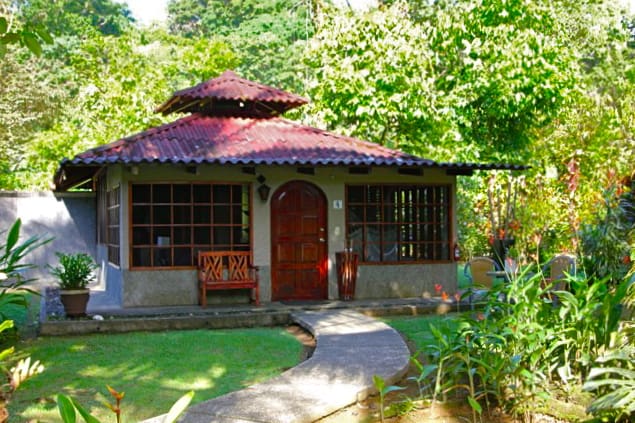
Casa Corcovado, Which Earned 5-Leaf Sustainability Rating from Costa Rica
TIPS FOR CHOOSING A GREEN HOTEL
6. When traveling in the U.S., check to see if the hotel has LEED Certification from the U.S. Green Building Council, which judges on sustainable site development, water savings, energy efficiency, material selection, indoor environmental quality, and innovation in design.
7. Look for seals of approval from other certification programs, such as EarthCheck (Australia), Green Globe, Rainforest Alliance (Latin America, Caribbean), and Green Tourism Business Scheme (UK).
8. Ask if the hotel has a recycling program. If not, encourage them to start one.
9. Look into the hotel’s sustainability initiatives, such as solar power, wind turbines, rainwater harvesting, energy-efficient lighting, and low-flow toilets.
10. Find out what percentage of the hotel’s resources is local. Do they hire local staff? Do they get most of their foods locally? Do they use locally sourced materials in the décor? Companies that utilize indigenous resources tend to be more sustainable, as they’re investing in the local economy.

Mary Showers at Screw’s Sulphur Spa in Dominica
WATER-SAVING TIPS
11. Take a BPA-free water bottle you can refill over and over again.
12. Take showers, not baths. Showers use just 10-25 gallons of water, while baths use up to 70 gallons. Feeling frisky? Shower with a friend and save even more water!
13. Take shorter showers, turning water off while you lather up, shave, and/or brush your teeth.
14. Never use hotel laundry, as they typically wash every guest’s clothes separately (even when there are only a few items).
15. Hang towels after each use, which is the universal sign that you’d like to use them again.
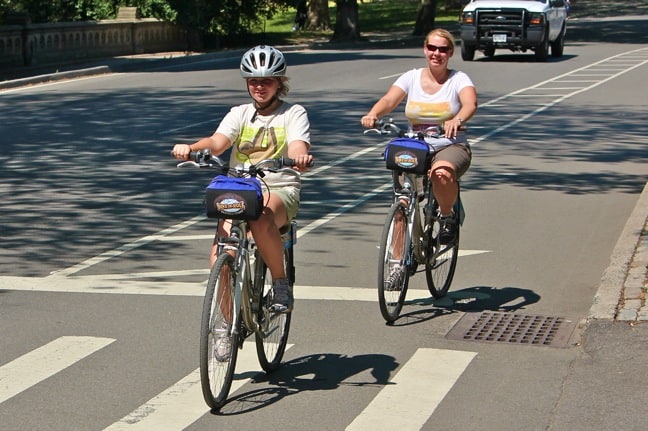
Mary & Alex Riding Bikes Around Central Park
ENERGY-SAVING TIPS
16. When you leave your room, turn off all lights, heat/AC, and television.
17. Leave the “Do Not Disturb” sign on the door for the duration of your stay, which cuts down on chemical cleansing agents, electricity used in vacuuming, and the washing of bed linens.
18. Walk, bike or use public transportation to get around whenever possible, which cuts down on gas usage and saves money.
19. Return maps, brochures and other tourist info once you’re finished with them.
20. Take any leftover soap, shampoo, or toothpaste with you. Unused portions are often thrown away, and you can reuse the plastic bottles in the future.
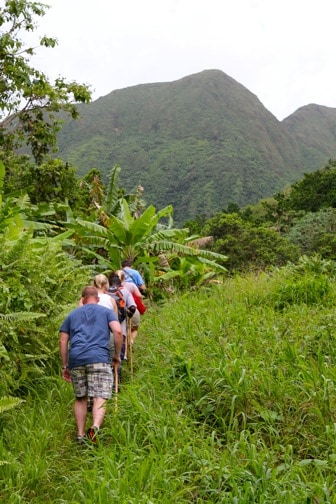
Hiking in the Rainforest of St Kitts
GREEN HIKING TIPS
21. Marked trails are there for a reason. Stick to the path to avoid harming native flora.
22. Bring along a small bag and pick up any trash you spot along your hike.
23. Never feed wildlife, for any reason. Feeding animals makes them habituated to and reliant on humans, and often leads to attacks (and subsequent death for the animal).
24. Research weather conditions and terrain before hiking. You don’t want to be that guy (or girl) who got lost and required a ranger rescue, which drains resources.
25. Keep a respectful distance from wildlife. Yes, we understand you want to Instagram your encounter with a grizzly. But if you’re close enough to attract an animal’s attention, you’re too damn close!

Shopping From Ribereños in the Peruvian Amazon with International Expeditions
GREEN SHOPPING TIPS
26. Buy locally made products, rather than those that have been imported. Items that are flown or shipped in have a much larger carbon footprint, and who wants a souvenir from an Asian assembly line?
27. Don’t buy anything made from endangered plants/animals, unsustainable hardwoods, or ancient artifacts. Not only is it wrong, but you probably won’t be able to get them through customs.
28. Take your own reusable bag. Plastic bags are SO 20th century…
29. Seek out indigenous artisans. When you buy directly from an artist, you’re not only helping them feed their family, but in many cases you’re helping to preserve their culture.
30. Do not buy souvenir photos from anyone exploiting wildlife, such as the famous performing elephants of Thailand.
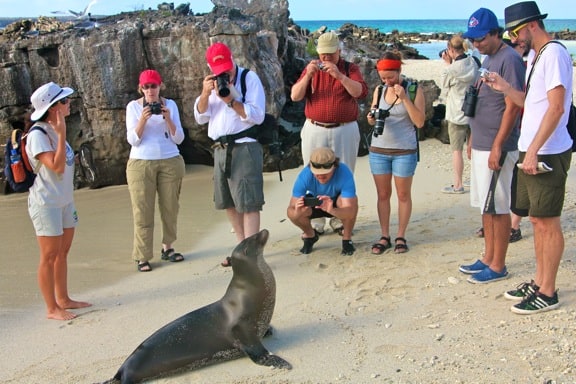
Exploring the Galapagos Islands With Ecoventura
ECO-TOUR TIPS
31. Travel with small group tour operators, which tend to have less of an environmental impact. Membership in an organization like The International Ecotourism Society is a good sign that the tour operator tries to conduct itself in a responsible, sustainable manner.
32. When snorkeling or Scuba diving, don’t touch/step on the coral or stir up sediment, as it can damage the reef’s fragile ecosystem.
33. Ask snorkel/dive operators if they chum the water. Doing so can change the behavior of marine species, or possibly make them sick.
34. Find out how the tour operator gives back to the local community. Do they lease the land from locals? Do they hire local guides? Do they take a leading role in preserving the area’s natural resources?
35. Don’t take any tour that promises hands-on encounters with wild animals, such as riding elephants or walking with tigers. If you do, you’re supporting an industry that illegally captures, transports, and abuses millions of animals each year.

Sunset Over Wadi Rum with New Friends Ali and Hassan
TIPS FOR BEING A TRAVELER, NOT A TOURIST
36. Honor local customs. Do a little research to learn about the local cultural traditions, so that you can speak and behave appropriately.
37. Ask for permission before taking a photo of someone. In some cultures, taking a person’s picture is like stealing their soul.
38. Learn the language. You don’t have to do a full Rosetta Stone course. But you’d be amazed by how knowing simple phrases such as “Thank you,” “My name is” and “Please help me” will impact the way locals will treat you.
39. Give back. Whether you sign up for a full-on voluntourism vacation or work with a non-profit like Pack For A Purpose to provide much-needed supplies, it doesn’t take a lot of extra effort to make a huge difference in the local community when you travel.
40. Immerse yourself in local culture. Half the fun of traveling is getting an opportunity to step outside your comfort zone and try different foods, listen to different music, and explore different cultures. Don’t be that guy who goes to India and insists on ordering a hamburger. –Bret Love; photos by Bret Love & Mary Gabbett
If you enjoyed our epic list of Green Travel Tips, you might also like:
GO GREEN TIP #101: How To Choose A Responsible Scuba Diving Operator
GO GREEN TIP #96: How To Choose a Green Hotel
GO GREEN TIP #82: The Green Way to Organize Your Home
GO GREEN TIP #66: Spring Green Your Home
Green Travel Tips- The Ultimate Guide to Sustainable Travel originally appeared on Green Global Travel.
(c) Green Global Travel – Read entire story here.





